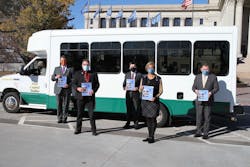Oklahoma’s first state transit plan increasing options in rural areas
The wheels are in motion on improved public transit in Oklahoma after more than one year of coordination by the Oklahoma Department of Transportation (ODOT) and the Oklahoma Transit Association (OTA), along with transit agencies statewide to develop the state’s first transit plan.
During a special ceremony in December 2020, the completed Oklahoma Public Transit Policy Plan was delivered by ODOT and OTA to legislative leaders from the Oklahoma Senate and the Oklahoma House of Representatives on the steps of the state capitol.
The comprehensive, statewide plan outlines the goals, strategies, objectives and priorities to make Oklahoma a top 10 state for public transit by 2040. Highlights include identification of the existing gap in funding for transit based on current and future projected needs, a strategic investment schedule outlining the best use of funds for the next 20 years, and an in-depth examination of transit funding options used by peer states.
“Completion of the state’s first transit plan is a milestone achievement in moving Oklahoma toward becoming a top 10 state for all modes of transportation,” Gov. Kevin Stitt said. “Thanks to the input from transit providers and users, we now have a roadmap for modernizing transit services and ensuring mobility for all Oklahomans.”
The plan focuses on currently available transit services: public bus, van, and streetcar. Oklahoma currently has 20 rural public transit providers operated by cities, counties, or community organizations, as well as 10 transit services operated by tribal governments serving nearly all 77 counties. Five urban transit agencies operate fixed-route and demand service in Edmond, Lawton, Norman, Oklahoma City, and Tulsa.
“While ODOT has incorporated public transit in long-range planning efforts before, I’ve never seen it done to this level in my 30 years with the state,” Secretary of Transportation and ODOT Executive Director Tim Gatz said.
While much focus is typically given to bus and rail service in urban areas, rural transit needs are rapidly growing in the state. Older Oklahomans living in rural areas are more commonly traveling longer distances to larger communities to work, shop, and access necessities like prescriptions, while also making trips to the Oklahoma City or Tulsa metro areas for medical care.
Research on transit use in rural Oklahoma during development of the plan found that 25% of all trips were taken for medical appointments, with smaller percentages for recreation or shopping. Areas of the state that originated most of the trips included exurban and rural portions of Logan County, just north of Oklahoma City, and several rural communities in far eastern and southeastern Oklahoma.
One of the first big public transit improvements to come after the plan’s adoption was the recent launch of PICK Transportation in several rural communities in eastern Oklahoma. PICK Transportation is an on-demand mobility service that connects users with a ride from one of Oklahoma’s rural transit providers through the Uber mobile app, which makes scheduling and payment easy. The partnership with Uber also allows rides to be offered for as little as $3. Rides are available evenings and weekends in the PICK Transportation service area.
The news of this service was very well received, as issues surrounding the ease of scheduling and payment have long been cited by both transit agencies and members of the public as barriers to access.
“With the growing popularity of on-demand ride-hailing options like Uber and Lyft, many predict that the Mobility as a Service framework is the future of public transit,” ODOT Deputy Director Dawn Sullivan said.
Creation of the Oklahoma Public Transit Policy Plan by ODOT and OTA was a key piece of House Bill 1365, which was enacted in 2019 to modernize public transportation by creating the Office of Mobility and Public Transit and reforming administration of state and federal funding for transit programs by ODOT. These reforms included bringing all public transportation programs administered by the state under one roof at ODOT.
The transit plan was developed through stakeholder and public input from the transit industry and users. This included numerous meetings with a steering committee of transit leaders, site visits and interviews with transit operators, and participation by partner agencies, government officials, and advocates. The department also hosted several regional public meetings in 2019 before the COVID-19 pandemic began and administered an online public survey that received more than 2,000 responses.
Goals identified in the transit plan for the next 20 years include meeting critical needs by 2025, expanding service by 2030, meeting a benchmark on par with peer states by 2035, and reaching mobility for all by 2040.
The full Oklahoma Public Transit Policy Plan can be viewed at www.oktransitplan.org.


